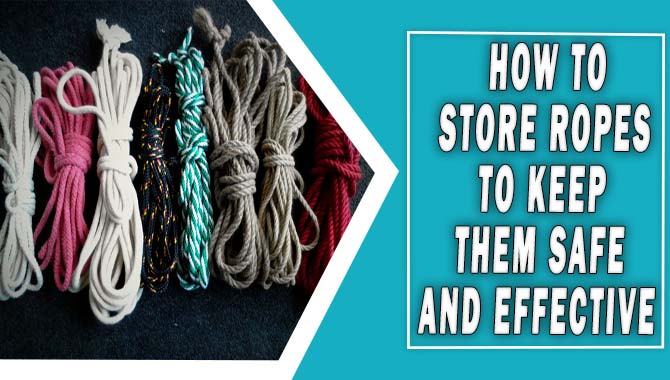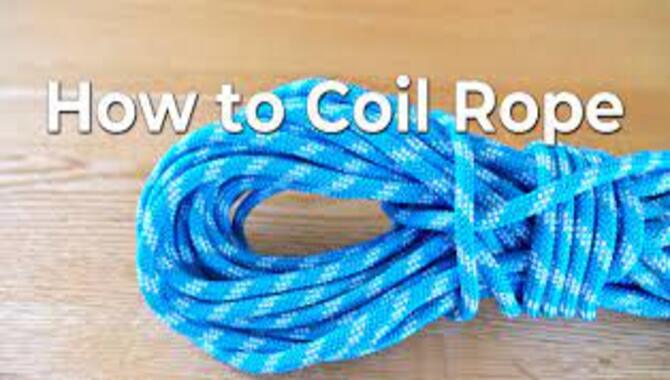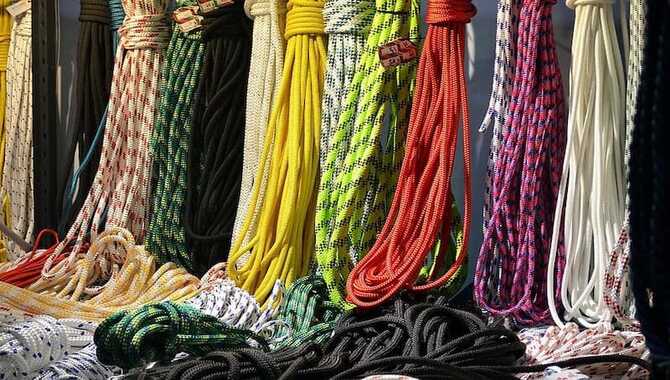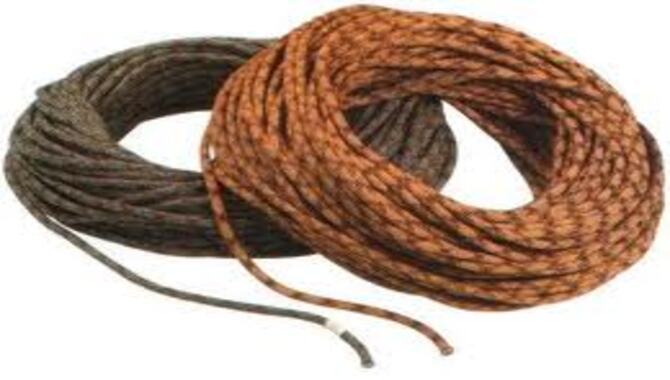Ropes are essential tools in any survival situation. You can use them to build shelters, create traps, and tie down objects. You can also use them for transportation, communication, and defense.
There are a variety of different ropes available on the market today, each with its unique properties and advantages. It’s important to choose the right rope for the job at hand so that you can achieve the desired results.
Have rope makers, rope owners, rope operators, rope users, rope admirers, rope lovers, and rope geeks worldwide. Yes, ropes are the lifelines of the modern age.
Forget the good old days when we had to rely on the strength of the human body to pull ourselves across the ground or water. We have the technology now to carry heavy loads with the help of ropes. But how do we store them safely and effectively? Well, we’re here to cover that in this blog.

3 Effective Ways To Store Ropes

When storing ropes, the best way to ensure the rope stays safe and effective is to keep it in a dry, cool place. Ideally, you should store ropes in a climate-controlled environment to prevent them from becoming brittle or crumbling. If you’re a climber or rappeller, you know that ropes are essential for safety. But, like anything else, they need to be stored properly to avoid becoming tangled and damaged. Here are 3 effective ways to store ropes:
1.Tying Rope In Figure 8

Tying rope in figure 8 is one of the most effective ways to store rope. This knot secures the rope so it cannot become tangled or slip out of place. It also prevents the rope from becoming over-extended, damaging it and making it less effective. By tying the rope in figure 8, you can ensure that your ropes stay safe and functional. You can use this knot to secure objects or cables in a variety of applications.
Tying rope in figure 8 is an important part of any rope storage system; it’s best to have multiple knots available for different applications. Overall, it’s important to have rope storage systems in place to protect your rope from damage and keep it working at its best.
2.Coiling The Rope

Ropes must be stored safely and effectively to ensure their longevity and functionality. When storing ropes, it is important to follow a few simple guidelines. First, ensure the rope is coiled in a way that does not create tension or kinks.
This will prevent the rope from fraying over time and help preserve the rope’s strength and durability. It is also best to coil the rope at a length of 5–10 times the rope’s length. This will ensure that the rope will coil evenly without creating excess weight or bulk.
After coiling the rope, ensure it is stored in a dry and dark place away from direct sunlight. This will help preserve the rope’s lifespan and improve its performance. Finally, if you need to use the rope for an application, uncoil it and ensure it is free from debris and knots before re-using it. By following these simple guidelines, you can ensure the safety and effectiveness of your rope storage procedures.
3.Putting The Rope Away

Ropes should be stored in a cool, dark place to preserve their strength and durability. You can easily store ropes in the closet or pantry of your home if you have the space available. However, you may want to consider stringing the rope across a beam or doorway to store ropes effectively.
This will save you the hassle of hanging them up and allows the rope to remain accessible if you need to use it quickly. Additionally, corduroy is a good material choice for storing ropes because it is moisture-resistant and durable. It can help protect the rope from damage.
Another effective way of storing ropes is using a rope bag or bin instead of hanging them up. These storage options are convenient as they can carry easily when climbing or hiking and are generally easier to store than hanging up individual ropes. Besides, rope bags and bins allow you to quickly access the rope whenever you need it without having to search through the whole collection of ropes.
The Different Ways To Store Ropes

There are a few different ways to store ropes, each with advantages and disadvantages. The most common way to store ropes is by keeping them in a dry, cool place. This is the safest option because it prevents the ropes from breaking or deteriorating. However, this method can be expensive because it requires extra storage space.
Another option is to keep ropes in an airtight container where they protect from moisture and other contaminants. This is a good option if you don’t have a lot of space, but it’s not as safe as storing them in a dry place because moisture can still damage the rope. The final option is to put the ropes in direct sunlight or near a heater. This is the least safe option because it can cause the rope to deteriorate faster than any other method.
Ropes Care And Maintenance.

Ropes are essential components of any construction project. However, the constant use of ropes can gradually reduce the rope’s strength and durability. To keep the rope’s strength and durability, it must properly maintain and store.
When using a rope, always store it in a dry and dark place to prevent sunlight from causing the rope to become brittle. Also, protect the rope from sharp objects and moisture to prevent damage to the rope’s fibers. After using the rope, store it in a way that does not restrict its movement to prevent kinks from developing.
When inspecting the rope for fraying, kinks, or other defects regularly, examine both ends to ensure that they are intact. If necessary, replace the rope with a new one to maintain its strength and durability.
Ropes For Climbing And Other Uses

Choosing the right rope for the application is of vital importance. Different types of rope are available for various applications, including climbing, rigging, and caving ropes. Each of these ropes has its unique characteristics and benefits.
In general, climbing ropes are made of high-tensile strength nylon or Kevlar and have a spiral construction with a flat end for grip. They are popular among climbers because they offer the strength and durability needed to support the climber’s weight in the rope, but they also have the responsive grip needed to let the climber feel the rope’s slip-angle as he or she or she climbs.
Rigging ropes are similar to climbing ropes but are typically coiled and made of Kevlar or other synthetic fibers such as nylon or polyamide. They use to secure rigging in place, such as harnesses and lines on a sailboat or the rigging of tall buildings. The coiling of these ropes makes them more durable than climbing ropes, making them an ideal choice for these applications.
Caving ropes are made of flexible synthetic fibers like Kevlar that provide the strength necessary to support heavy loads when climbing through narrow passages in caves. These ropes come 1-10 meters long and have a coiled-coil end for grip.
It’s also important to keep any rope tidy and organized, so it doesn’t become tangled or damaged by dirt or debris during use. Storing your rope securely and effectively will ensure it lasts longer and is ready when needed.
How To Reduce Rope Vulnerability
When you are using rope, it’s essential to keep the rope safe and effective. The most important step to maintaining the rope’s lifespan and safety is storing the rope properly.
To reduce the vulnerability of ropes, you should store the rope in a dry and cool place. Additionally, you should use a protective bag when storing the rope. This will help to protect the rope from dirt and moisture.
Furthermore, when storing the rope, it is vital to minimize the risk of it tangled. You can use baskets or other similar containers to hold the rope in an organized manner. Lastly, you must remove knots and splices before storing the rope. This will ensure that the rope remains undamaged and intact.
Conclusion
Ropes are perfect for tying objects together. They’re versatile and easy to use, making them a great choice for tying down tents or fishing nets. Ropes can use to create footholds and suspension bridges. You can also use them to create animal traps or snares.
Ropes make it easy to move heavy objects or people around. They’re strong enough to support the weight but flexible enough that you don’t have to worry about them breaking if you accidentally strain them too much.
Ropes can use for a variety of purposes, from securing cargo to building structures to traveling long distances. They’re commonly found in the security industry, where the rope is often the
Frequently Asked Questions:
1. What Is The Best Way To Store Ropes?
Ans: It is important to store ropes properly to keep them working effectively and for their lifespan. Here are some tips on how to do so:
- You should store ropes in a dry and cool place.
- You should not store ropes together with metal objects.
- You should not store ropes with sharp objects.
2. Should I Tie My Rope With A Knot Or Use A Loop?
Ans: Using a knot is always the best option when tying your rope the safest way. A knot is designed to stay tight and is less likely to loosen over time. In addition, make sure the knot is tight enough so that it does not slip or come undone when you are climbing or moving the rope around.
3. How Do You Store Rope Without Tangling?
Ans: To store rope without any problems, follow the following instructions:
- Store ropes in a dry and dark place.
- Make sure the ropes are tightly rolled and stacked on top of each other.
- Do not store ropes near heat or heavy objects.
4. How Do You Wrap A Rope For Storage?
Ans: The most common way to wrap a rope for storage is by wrapping it around a pulley or spool. When wrapping the rope, it is important to make sure the ends are tight, and the rope is not twisted. Keeping the area where the rope stores clean and free of debris is also important.
5. How Do You Store Climbing Ropes?
Ans: Climbing ropes should store in a dry, dark place. They should not expose to direct sunlight or heat, as this can damage the rope’s fibers. Ropes should also store in a tightly sealed container to prevent them from becoming tangled. preferred access method. They’re strong and versatile, and the above methods can help ensure they remain so for as long as possible.

Leave a Reply